#Adolph Simmon
Explore tagged Tumblr posts
Text
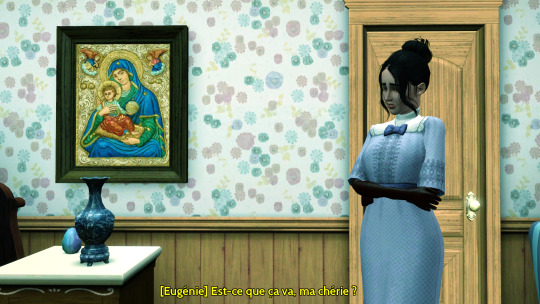




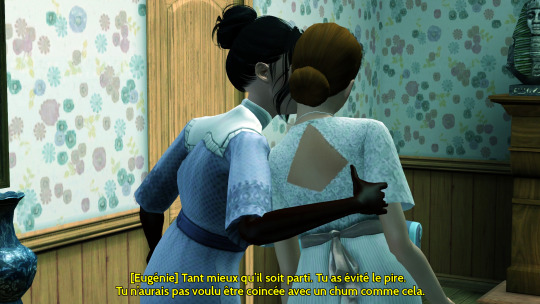
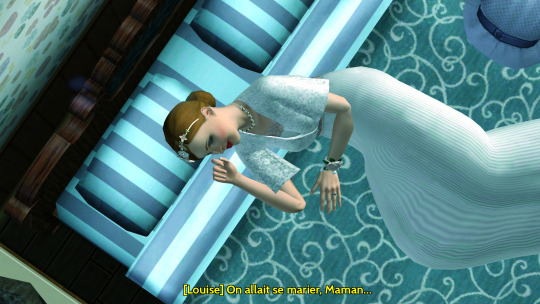
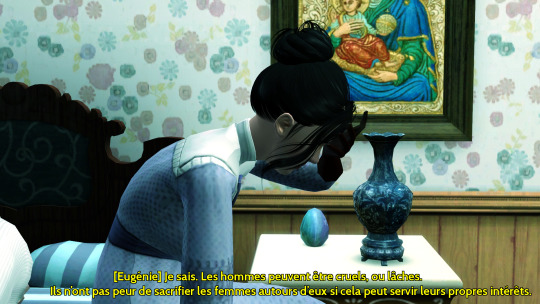
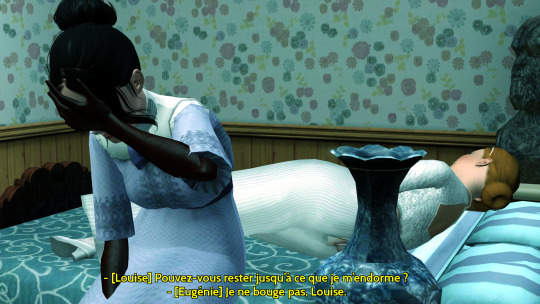

Printemps 1918, Al Simhara, Égypte (14/20)
Il va sans dire que Simmon, l’oncle comme le père, sont furieux, car toute cette affaire les fait passer pour des tarlas et met en jeu leur crédibilité même sur l’île. Toute cette affaire a eu lieu il y a quelques mois, et avec le recul, vous voulez savoir le pire ? Moins d’un quart des hommes conscrits sont effectivement partis à la guerre. Les deux tiers se font exempter ! À Hylewood, parmi les conscrits, personne n’est parti en Europe et tout le monde est déjà de retour à la maison. Comme quoi, il n'était pas nécessaire d’en faire tout un plat et d’abandonner ma fille à l’autel…
[Transcription] Eugénie Le Bris : Est-ce que ça va, ma chérie ? Louise Le Bris : Non, Maman. Oh, où est-il ? Comment a-t-il pu faire une chose pareille ? Eugénie Le Bris : Il a laissé une lettre dans sa chambre en partant… Il fuit la conscription car il ne veut pas mourir en Europe. Il ne dit naturellement pas où il se rend, ou quand il sera de retour. Louise Le Bris : Il aurait pu m’en parler !… J’aurais pu le suivre, j’aurais pu venir avec lui ! Eugénie Le Bris : C’est qu’il ne voulait pas que tu viennes. Eugénie Le Bris : Tant mieux qu’il soit parti. Tu as évité le pire. Tu n’aurais pas voulu être coincée avec un chum comme cela. Louise Le Bris : On allait se marier, Maman… Eugénie Le Bris : Je sais. Les hommes peuvent être cruels, ou lâches. Ils n’ont pas peur de sacrifier les femmes autours d’eux si cela peut servir leurs propres intérêts. Louise Le Bris : Pouvez-vous rester jusqu’à ce que je m’endorme ? Eugénie Le Bris : Je ne bouge pas, Louise.
#ts3#simblr#legacy challenge#history challenge#decades challenge#lebris#lebrisgen3ter#Jules Le Bris#Eugénie Bernard#Louise Le Bris II#Earnest Simmon#Peter Simmon#Adolph Simmon
8 notes
·
View notes
Text
The Giant Eurypterid Trackway: A Great Fossil Discovery on Display in the Carnegie Museum of Natural History

Figure 1.
When museum patrons enter Carnegie Museum of Natural History’s Benedum Hall of Geology, they encounter a one-ton block of coarse sandstone with a series of bilateral footprints encased on the rock’s surface. Most visitors don’t know what type of creature made these footprints (Fig. 1) or realize that this fossil trackway represents one of the great fossil discoveries in the history of western Pennsylvania paleontology.
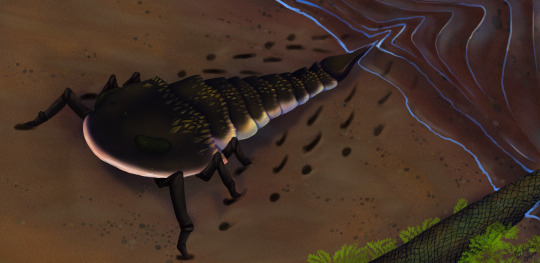
Figure 2. Illustration by Kay Hughes.
Last month, the cover of Pennsylvania Geology (Fig. 2) helped address both deficiencies. The magazine bears a colorful illustration by Kay Hughes of a 315 million-year-old scene: a large six-legged arthropod emerging from the water and dragging its tail onto a sand bar among fallen Lepidodendron logs. The intruder is a Giant Eurypterid, a creature known to science as Palmichnium kosinskiorum, and a member of an extinct family of arthropods informally called “sea scorpions” that are distant biological cousins.
Within the journal is a fuller explanation for the artistic interpretation of the creature behind the Benedum Hall trackway, an article I co-wrote with Kay Hughes and John Harper titled, Reflections on Palmichnium kosinskiorum-The Footprints of Pennsylvania’s Elusive Elk County Monster.
Fortuitous Discovery

Figure 3. Photograph of Elk County in situ trackway looking southward (Brezinski and Kollar 2016).

Figure 4. Trackway closeup showing tail drag on display in Benedum Hall of Geology (Brezinski and Kollar 2016)
Seventy-two years ago, in an Elk County section of the Allegheny National Forest, James Kosinski, a preparator in the Education Department of Carnegie Museum of Natural History, and his brother Michael were hunting deer in heavily wooded terrain. When Michael stumbled upon a large sandstone boulder bearing a pattern of unusual impressions, he informed James, who (Fig. 3) immediately recognized the impressions as the fossil tracks of an unknown animal (Fig. 4).
Later, when James described the discovery to Carnegie Museum’s Dr. E. Rudy Eller, Curator of the Section of Invertebrate Paleontology, and Dr. J. Leroy Kay, Curator of Vertebrate Paleontology, plans were made to remove a section of the boulder containing the best-preserved section of the trackway and transport the heavy block to the museum.
Exhibit History

Figure 5. Former Paleozoic Hall Silurian Period Marine Diorama with Eurypterids.
Upon arrival at the museum in 1948, the sandstone block was prepared for exhibition and placed near the museum’s Coal Forest exhibit in 1949. In 1965, the trackway was incorporated as a floor centerpiece in the newly open Paleozoic Hall which featured dioramas of characteristic life forms of that Era’s time periods (Cambrian, Ordovician, Silurian, Devonian, Pennsylvanian, and Permian) along with representative fossils from the museum collection. (Fig. 5) In 1998, when Paleozoic Hall was dismantled, the trackway was placed temporarily in the Invertebrate Paleontology lab. The trackway returned to public view in 2007 as part of Bizarre Beasts, a temporary exhibition in the R. P. Simmons Family Gallery about unusual life forms. When Bizarre Beasts closed, I worked with James Senior, Chair of the museum’s Exhibit Department, to place the trackway in the Benedum Hall of Geology entrance as an introduction to great fossil discoveries from western Pennsylvania.
The Research – Locality Data Supports Recent Theory
The fossil trackway was initially identified by Dr. Kay as a hopping reptile inhabiting a Pennsylvanian coal forest 300 million years ago. Although Dr. Eller, citing his own research, suggested the track was formed by a crawling eurypterid, it would take 35 more years for the fossil trackway to be studied by expert arthropod paleontologists from Europe.
The eventual designation of Palmichnium kosinskiorum as a holotype specimen (CM 34388), a category of first order scientific importance, dates to the fossil’s description as a eurypterid trackway in a 1983 research paper by Dr. Derek E. G., Briggs and Dr. W. D. J. Rolfe, titled, A giant arthropod trackway from the Lower Mississippian of Pennsylvania (Journal of Paleontology, 57, 377 – 390). In paleontology, when a non-scientist such as Michael Kosinski discovers a fossil of importance, paleontologists, in this case Derek Briggs and Ian Rolfe, name the new fossil species after the founder, hence P. kosinskiorum.
For years, paleontologists in the Section of Invertebrate Paleontology assumed the scientific conclusions of Briggs and Rolfe (1983) about the eurypterid trackway were beyond dispute. This situation changed in 2009, when Yale University Professor Adolph Seilacher, a world-renowned expert on fossil trackways visited the museum. While Briggs and Rolfe concluded the trackway formed in a marine sandstone, Seilacher explained to me that the trackway was likely formed in an eolian or wind-blown sand environment. He also recommended that someone investigate the rocks at the fossil location in Elk County to substantiate his hypothesis.

Figure 6. D.K. Brezinski at trackway.
Later that year, when I accompanied David K. Brezinski, Associate Curator Adjunct, Section of Invertebrate Paleontology, to re-locate and re-examine the sandstone boulder with the remaining tracks, we discovered the original geologic and deposition conclusion by Briggs and Rolfe (1983) was incorrect (Fig. 6). In 2011, we reported these new findings at the Northeastern Sectional Meeting of the Geological Society of America in Pittsburgh. After the meeting, we continued our research and eventually published our conclusion that the geologic age of the trackway was Early Pennsylvanian age and the embedded footprints represented a fluvial sand bar environment of deposition.(Reevaluation of the Age and Provenance of the Giant Palmichnium Kosinskiorum Eurypterid Trackway, from Elk County, Pennsylvania, Brezinski and Kollar (2016), Annals of Carnegie Museum 84, 39 – 45,)
School Groups and Museum Interpreters
Based upon repeated anecdotal reports from the Interpreters who guide tour groups through the museum’s exhibit halls, the eurypterid trackway is one of the most celebrated education stops for elementary school students. According to Interpreter Patty Dineen, the appealing factors of the trackway include the size and possible scariness of the creature who made the tracks, the fact the track-maker lived long before the dinosaurs, the fossil’s local origin, and the sheer amount for information that can be gathered from the ancient preserved tracks.
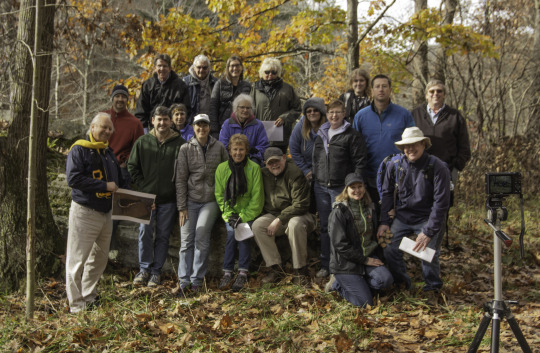
Figure 7. Interpreter field trip.
As part of an effort to better inform school groups about the eurypterid trackway, in 2017 Patty Dineen and Joann Wilson, co-coordinators and instructors for the museum’s Natural History Interpreters, arranged for six Interpreters to participate in a PAlS geology fall field trip to the fossil site in Elk County. (Fig. 7) An important by-product of field excursion was the creation of an instructional video that explains how museum scientists conduct research.
“Treasures of the Carnegie” Planning for a better Trackway Experience
Now that an illustration exists (Fig. 1) of the eurypterid that shaped the trackway walking out of the 315 million-year-old Olean River onto a sand bar, it might be time to consider how to best devise an improved visual and virtual tour experience for the Carnegie patrons and school groups.
Albert D. Kollar is Collections Manager for the Section of Invertebrate Paleontology at Carnegie Museum of Natural History. Museum staff, volunteers, and interns are encouraged to blog about their unique experiences and knowledge gained from working at the museum.
#Carnegie Museum of Natural History#Geology#Pennsylvania geology#Giant Eurypterid Trackway#Fossils#Invertebrate Paleontology#Pennsylvania#Giant Eurypterid
86 notes
·
View notes
Video
Why Is Trump Holding Back JFK Assassination Files
I hold the answers to that question. BS "National Security" It's in the interest of these greedy domestic terrorist scum. I'm Max Weber Jr's grand-daughter... His son, Adolph Weber was my father. My father Adolph had an affair with his daughter in law, that's my mother, MaryAnn... they did it to preserve bloodlines and to prevent them from being Nazi tainted & secure that our fortunes would be preserved and returned. My father and his brother Otto had to marry the daughters of Hitler & Eva Braun in order to come to the USA and survive the Holocaust as most of our family were wiped out - murdered. As a side -note, I met Werner von Braun as a child as he was my father Adolph's wife Hannah.
The US held some of our fortune for a certain duration and Nazi Germany held some - reparations for Holocaust survivors (Weber is a Jewish surname) were handled where my great Uncle Alfred Weber, Max's brother, lived: in Switzerland - specifically held at the Swiss Bank - hence all those whistleblowers since Nazi-looted monies were being returned. That was 1994 and the Nazi & KKK & others (read inc. Bush) here were going to make certain those of us who are real Jews would never see a dime of our monies.
Now go back to Nov 1963, my mother was a few months pregnant with me - so what did those greedy SOBs do? Sent her husband, who is also my 1/2 brother (a Marine who spent a year at West Point then worked/defense at Long Island - hint, hint) undercover to Dealey Plaza, Texas... he missed his shot, he made the wrong one, but JFK had 11 bullet holes in him, so he really had no chance to stop the assassins. It was also the same day my mother found out she was pregnant with me - and that's how those of EMPIRE play...always aim for the greatest shock/trauma value.
I lived with my maternal grandparents (Rosato/Rosetta) and then at 5 moved to Le Guin's Omelas (Continental Village/Garrison, NY) to live with my mother, her husband and their 2 children - by the age of 8, full time. And then the BrainTrust et al found me & started fawning over me, that's when I got offered up for my older 1/2's illegitimate son, Leo to be made a star and me to be destroyed. All the Paperclips and Paperclips like my half-siblings who people call, "crypto-Jews" pounced on me, constant COINTELPRO, constant attacks with DEWs, etc. A small group tried to look out for me.... but the criminals put my mother's idiot cousin Joseph Bruno in NYS government as a Senator. Joe used to run quasi-legit furniture warehouses for the mob which probably exposed him to Simmons Furniture.. all done to try and keep those monies stolen. In '87 when I was going to move to California, they put Joe & my mother's distant cousin in government: Pizzagate Pelosi. I got to CA in latter October '89. I know now that the 10/17/89 Loma Prieta earthquake (when I was half-way cross country on my move to CA) was a HAARP warning shot or "shout out" to CA.
In 1985, my mother and her husband were convicted of felony child abuse and neglect against my younger half brother, Erik. They were also convicted of attempted murder against me & my mother (possibly her husband, too) certified sociopathic by the State. That went through 8 courts, 4 counties - the State gave me emergency custody of my younger half-brother. Their sentencing was a joke, but they were doing better (famous good psychiatrist, Dr. Ehrlich who magically dropped dead in the beginning of treating them.)
94 everything changed for us and the good people of the USA. This misogynist garbage of the KKK (Simmons), BlackOps, PsyOps, Paperclips and other criminals of the infamous "CIA" went insane. They also cleared everyone out of my life they could, sending a Royal Bildeberg nephew my way who I later learned was a Project Artichoke NIGHTMARE & I didn't know how extensive the "Stepford Wife" neuro-weapons of MK-ULTRA were or their comprehensive usage. 12/29/95 I had my son, Samuel. What i didn't know about was all the cybernetic, genetic & social engineering (in the hands of psychopaths) goings on. There are numerous faux relatives created by gene-editing & egg stealing that I never knew about - all claiming relation when I never knew or condoned despite the "CIA" asking me several times for my eggs... You see, they stole all my work, my inventions, my performances (me playing Mahler in Shutter Island.. I was a child) my academic disciplines, treatment modalities, business ideas, Africa Agenda 2000 work, you name it, they stole it. Even my old Psalme Book (400 and something year old psalme book)that the COO of Booz Allen, a Jewish Philanthropist later bought. Years prior I had the CIA/FED crew create trusts and funds for Americans in need from those works, just a percentage of the profits... all together 100 trillion or more of my wealth all stolen or extorted from enemies of the State.. I've NEVER seen a DIME of my monies...and my younger half-nephew, Leonardo di Caprio might be a wealthy movie star, but he's just a lonely, exploited, messed up tool for this absolutely deranged agenda.
I could not list out what must be literally a few million crimes done to me and my son - even making me a pre-911 witness so as to frame their BS false-flag as UBL & some dignitaries did 911 for me (I am also a dignitary) when the TRUTH was that corrupt or exploited Politicos & Paperclip, KKK military war-criminals had stolen ALL of that wealth, not just mine, but many others long, long ago (George Tenet must be forced to PUBLICLY tell the Truth on this one). Numerous top journalists came running to me after 911 & the Iraq invasion like Seymour Hersh, Greenwald, Madsen, some NYTimes, Tribune, International media etc, etc, etc.... hell, even Johnny Cochran was going to help me and voila! he dies suddenly. Or how they pulled out these notorious female mass-murderers out of NYS's Prison for the Criminally Insane and tried to do Identity-Switcheroo to me and some other great women (mind you, most of those cretins belonged or were on death-row). They've put me in their slow-kill or "NSA" (as in No Such Agency) soft-kill, but I've been hit with every covert weapon there is on Earth... they're just pissed I'm still alive, not sure if my kidnapped son is.... we are the last straw for America and the Deep State SCUM know it.
0 notes
Text
Arxiv[quant-ph]
Overcoming the Sign Problem at Finite Temperature: Quantum Tensor Network for the Orbital eg Model on an Infinite Square Lattice - Piotr Czarnik, Jacek Dziarmaga, Andrzej M. Oleś
Matrix product states for topological phases with parafermions - Wen-Tao Xu, Guang-Ming Zhang
Charged String Tensor Networks - Jacob Biamonte
Rigorous renormalization group method for ground space and low-energy states of local Hamiltonians - Brenden Roberts, Thomas Vidick, Olexei I. Motrunich
Ubiquitous non-local entanglement with Majorana bound states - Alessandro Romito, Yuval Gefen
Entanglement and fluctuations in the XXZ model with power-law interactions - Irénée Frérot, Piero Naldesi, Tommaso Roscilde
Universality in volume law entanglement of pure quantum states - Hiroyuki Fujita, Yuya O. Nakagawa, Sho Sugiura, Masataka Watanabe
Preparing GHZ and W states on a long-range Ising spin model by global controls - Jiahui Chen, Hui Zhou, Changkui Duan, Xinhua Peng
Entanglement Entropy of Typical Eigenstates of Translationally Invariant Quadratic Hamiltonians - L. Vidmar, L. Hackl, E. Bianchi, M. Rigol
Topological Protection of Coherence in a Dissipative Environment - Lorenzo Campos Venuti, Zhengzhi Ma, Hubert Saleur, Stephan Haas
On Defects Between Gapped Boundaries in Two-Dimensional Topological Phases of Matter - Iris Cong, Meng Cheng, Zhenghan Wang
Observation of topological Bloch-state defects and their merging transition - Matthias Tarnowski, Marlon Nuske, Nick Fläschner, Benno Rem, Dominik Vogel, Lukas Freystatzky, Klaus Sengstock, Ludwig Mathey, Christof Weitenberg
Topological properties of a dense atomic lattice gas - Robert J. Bettles, Jiří Minář, Igor Lesanovsky, Charles S. Adams, Beatriz Olmos
Many body localization transition in quantum spin glasses on the Bethe lattice - Gianni Mossi, Antonello Scardicchio
Entanglement Complexity in Quantum Many-Body Dynamics, Thermalization and Localization - Zhi-Cheng Yang, Alioscia Hamma, Salvatore M. Giampaolo, Eduardo R. Mucciolo, Claudio Chamon
Nonequilibrium quantum phase transition in strongly coupled spin chains - Eduardo Mascarenhas, Giacomo Giudice, Vincenzo Savona
Markovian evolution of quantum coherence under symmetric dynamics - Matteo Lostaglio, Kamil Korzekwa, Antony Milne
Two-qubit entangling gates between distant atomic qubits in a lattice - A. Cesa, J. Martin
A robust boson dispenser: Quantum state preparation in interacting many-particle systems - Irina Reshodko, Albert Benseny, Thomas Busch
Long-range interactions between ultracold atoms and molecules - Maxence Lepers, Olivier Dulieu
Analytical and numerical studies of Bose-Fermi mixtures in a one-dimensional harmonic trap - A. S. Dehkharghani, F. F. Bellotti, N. T. Zinner
Converting quasiclassical states into arbitrary Fock state superpositions in a superconducting cavity - W. Wang, L. Hu, Y. Xu, K. Liu, Y. Ma, Shi-Biao Zheng, R. Vijay, Y. P. Song, L.-M. Duan, L. Sun
Implementing supersymmetric dynamics in ultracold atom systems - M. Lahrz, C. Weitenberg, L. Mathey
Circuit configurations which can/cannot show super-radiant phase transitions - Motoaki Bamba, Nobuyuki Imoto
On the correlation measure of two-electron systems - Aparna Saha, B. Talukdar, Supriya Chatterjee
Crossing Over from Attractive to Repulsive Interactions in a Tunneling Bosonic Josephson Junction - G. Spagnolli, G. Semeghini, L. Masi, G. Ferioli, A. Trenkwalder, S. Coop, M. Landini, L. Pezze', G. Modugno, M. Inguscio, A. Smerzi, M. Fattori
Superfluidity and relaxation dynamics of a laser-stirred 2D Bose gas - Vijay Pal Singh, Christof Weitenberg, Jean Dalibard, Ludwig Mathey
Remote entanglement stabilization for modular quantum computing - Nicolas Didier, S. Shankar, Mazyar Mirrahimi
Topological classification of time-asymmetry in unitary quantum processes - Jacob Biamonte, Jacob Turner
A Discrete Fourier Transform on Lattices with Quantum Applications - Lior Eldar, Peter Shor
Heat-Bath Algorithmic Cooling with correlated qubit-environment interactions - Nayeli A. Rodriguez-Briones, Jun Li, Xinhua Peng, Tal Mor, Yossi Weinstein, Raymond Laflamme
Quantum Variational Principle and quantum multiform structure: the case of quadratic Lagrangians - Steven D. King, Frank W. Nijhoff
Phonon-mediated repulsion, sharp transitions and (quasi)self-trapping in the extended Peierls-Hubbard model - John Sous, Monodeep Chakraborty, Clemens P.J. Adolphs, Roman V. Krems, Mona Berciu
Quantum coherence and quantum correlations - Ming-Liang Hu, Xueyuan Hu, Yi Peng, Yu-Ran Zhang, Heng Fan
Generation of maximally correlated states in the absence of entanglement - C. E. López, F. Albarrán-Arriagada, S. Allende, J. C. Retamal
No-signaling principle and Bell inequality in PT-symmetric quantum mechanics - George Japaridze, Dipendra Pokhrel, Xiao-Qian Wang
Emergent deterministic systems - Ian T. Durham
The Quantum Cheshire Cat effect: Theoretical basis and observational implications - Q. Duprey, S. Kanjilal, U. Sinha, D. Home, A. Matzkin
Polygamy relation for the entanglement of Rényi-α entropy in multi-qubit systems - Wei Song, Jun-Long Zhao, Li-Hua Zhang, Da-Chuang Li, Ming Yang, Zhuo-Liang Cao
Symmetric Laplacians, Quantum Density Matrices and their Von-Neumann Entropy - David E. Simmons, Justin P. Coon, Animesh Datta
SLOCC classification of n qubits invoking the proportional relationships for spectrums and for standard Jordan normal forms - Dafa Li
0 notes
Text
American History!!
February 10, 2017 *Henry Plummer Cheatham (December 27, 1857 – November 29, 1935) was an educator, farmer and politician, elected as a Republican member of the United States House of Representatives from 1889 to 1893 from North Carolina. He was one of only five African Americans elected to Congress from the South in the Jim Crow era of the last decade of the nineteenth century, as disfranchisement reduced black voting. After that, no African Americans would be elected from the South until 1972 and none from North Carolina until 1992.
Early life Born into slavery in 1857 in what is now Henderson, North Carolina, Cheatham had an enslaved mother and a white father who was rumored to be a prominent local man.
After the Civil War and emancipation, he attended the first public schools for black children in Vance County, established by the state legislature in the Reconstruction era. With the financial aid of a white friend, Robert A. Jenkins, Cheatham attended Shaw University, a historically black college in Raleigh, North Carolina, where he graduated in 1883.
He worked briefly as a school principal before being elected as the Register of Deeds for Vance County (1884–1888), which was majority black and Republican. In this period, the Democrats had regained control of the state legislature, but many blacks continued to be elected to local office, as the state was more than 30% black.
Marriage and family In 1884, Cheatham married Louisa (or Louise) Cherry, who had been a fellow student at Shaw. She taught music at the school where he had been principal. They had three children: Charles, Mamie, and Henry Plummer, Jr. Her sister Cora Lee Cherry married George Henry White in 1886, who also became active in politics and was elected as a U.S. Congressman after Cheatham had served. The proposed Cheatham-White Scholarship program, intended for North Carolina A&T State University and North Carolina Central University students, is named for both congressmen.
After Louisa Cheatham died in 1899, Henry married Laura Joyner. They also had three children: Susie, Richard, and James.
Political career Cheatham became active in Republican politics. He encouraged the establishment of institutions for African Americans, such as the Colored Orphan Asylum in Oxford in 1883 and the founding of state normal schools for the training of black teachers.
US Congressman In 1888, Cheatham was narrowly elected to Congress from North Carolina's 2nd congressional district over the incumbent Furnifold M. Simmons. (Simmons would later lead the white supremacy campaigns that resulted in a new state constitution that disfranchised black citizens.) During the campaign, Cheatham was reported by North Carolina papers to have allegedly told black voters that Simmons and President Grover Cleveland would re-enslave them. Other press outlets of the time dismissed these allegations by the press as hyperbole or having misrepresented Cheatham's words.
In a period of disfranchisement of blacks in the South, Cheatham was one of five African Americans elected to Congress during the Jim Crow era of the late nineteenth century. There were two from South Carolina, his brother-in-law George Henry White who followed him from North Carolina, and one from Virginia. After them, no African Americans would be elected from the South until 1972, after federal civil rights legislation enforcing constitutional rights for citizens. No African American would be elected to Congress from North Carolina until 1992.
Cheatham, then the only black North Carolina congressman, supported federal aid to education, and the McKinley tariff. He also supported the Federal Elections Bill in 1890, introduced by Henry Cabot Lodge, to provide federal enforcement to safeguard the voting rights of African Americans in the South. House Republicans had been concerned about the discriminatory practices of the Democrats and trying to gain passage of a bill since the 1880s.
Lodge's bill narrowly passed the House but died in the Senate. Republicans were unable to get federal legislation passed on this issue as the Southern Democratic voting block became more powerful.
Cheatham tended mostly to the needs of his constituents (of both races), but did not succeed in getting his own bills passed. Cheatham served on the House committees on Education, Expenditures on Public Buildings, and Agriculture, one of the more powerful.
In 1890, Cheatham defended his seat and defeated the Democrat James M. Mewborne, with 16,943 votes to 15,713. But nationwide, Democrats re-took the House of Representatives, which meant that measures to protect black civil rights would not be passed. Cheatham was the only black congressman in the Fifty-second Congress (he had also been the only black congressman in the first half of the 51st Congress).
He unsuccessfully sought re-election to a third term in 1892, after the North Carolina legislature changed the boundaries of his congressional district. Competition from a Populist on the ballot split some of the vote, contributing to the victory of Frederick A. Woodard, a Democrat.
Cheatham ran against Woodard again in 1894 without success. In 1896, he competed for the Republican nomination for the district against his brother-in-law, George Henry White, who won as the next (and last) late nineteenth-century black congressman from North Carolina. Later life
In 1897, President William McKinley's administration appointed Cheatham as federal Recorder of Deeds for the District of Columbia, a prestigious and lucrative patronage position which he held through 1901 and the change in administrations. Cheatham, a friend and ally of Booker T. Washington, was criticized for standing by McKinley, as the Republican administration did little to offset the rising tide of Jim Crow racism and segregation in the South.
New state constitutions were passed in the South from 1890 to 1908 that disfranchised black citizens for more than half a century, but their provisions generally survived US Supreme Court review. If one provision was declared unconstitutional, southern states passed new ones to create new obstacles. (See Disfranchisement after Reconstruction era)
After four years in Washington, D.C., Cheatham returned to farm in Littleton, North Carolina.
He moved to Oxford when appointed as superintendent of the state Colored Orphan Asylum, which was located there.
He served in that position for 28 years. Cheatham had supported the state legislation to establish the orphanage in 1883, as part of Reconstruction-era programs to provide for the welfare of people. He "was its superintendent and to him more than any man, is due the credit for the remarkable progress and development of the institution." He died in Oxford in 1935.
Known as an educated, discreet, and diplomatic man, Cheatham impressed even the white-supremacist Democrat Josephus Daniels. He said that he regarded Cheatham highly as a man who had gained the confidence of both races.
* Walter L. Cohen, Sr. (January 22, 1860 – December 29, 1930) was an African-American Republican politician and businessman in the U.S. state of Louisiana.
The New Orleans native was the son of Bernard Cohen and the former Amelia Bingaman. Like his better-known compatriot Homer Adolph Plessy, Cohen was a free black prior to passage of the Thirteenth Amendment to the United States Constitution. He was Catholic by religion, but had some Jewish ancestry, and he noted that he was part of the most-hated ethnic group and most-hated religious group by the resurging Ku Klux Klan.
Educated in New Orleans, he was married to the former Antonia Manadé, and the couple had three children: Walter Cohen, Jr., Bernard J. Cohen, and Margot C. Farrell.
Political career Cohen's political activity mushroomed in the 1890s, after the Reconstruction era, when he became one of the few blacks to hold appointed office into the 20th century. During this period, Cohen and fellow black Louisiana federal appointee James Lewis were the most important political allies of Booker T. Washington in the state, which played a role in their success. U.S. President William McKinley named Cohen a customs inspector in New Orleans.
McKinley's successor, Theodore Roosevelt, appointed him register of the federal land office. (Louisiana at the time elected a register of state lands, among them the first woman in statewide elected office in the 20th century, Lucille May Grace.)
Even when the African-American-dominated Black and Tan faction lost power after 1912 to the Lily-White Movement within the Republican Party, Cohen obtained the position of comptroller of customs by appointment from President Warren G. Harding. He succeeded A.W. Newlin as comptroller of customs. The New York Times referred to the office as "one of the most lucrative federal offices" in the U.S. South. Harding's successor, Calvin Coolidge, renewed Cohen's appointment. Though he had been a delegate to all Republican National Conventions between 1896 and 1924, Cohen was later ousted as secretary of the now 144-member Louisiana State Republican Central Committee and instead headed a dissenting group. In 1928, Cohen favored U.S. Senator Charles Curtis of Kansas for the Republican presidential nomination, but the party selection went nearly unanimously to Herbert Hoover, the outgoing secretary of commerce. Curtis then became the GOP vice presidential nominee. In 1928, Coolidge offered Cohen the position of minister to Liberia, but he declined the offer.
A successful businessman, Cohen was the founder and president of the People's Life Insurance Company in New Orleans, a large industrial company whose clients were blacks. Cohen was a member of Corpus Christi Catholic Church in New Orleans. He died in New Orleans and is interred there at St. Louis Cemetery III, 2022 Saint Bernard Avenue.
Cohen's death came some six years before black voters began a longstanding shift from Republican to Democratic Party allegiance with the reelection in 1936 of Franklin D. Roosevelt.
Legacy Walter L. Cohen High School in New Orleans is named in his honor.
* Abram Colby was an American slave and politician who served in the Georgia House of Representatives during the Reconstruction era. A resident of Greene County, Georgia, Colby was the son of an enslaved woman and a white planter. He was free for fifteen years prior to emancipation. He was an early organizer of freed slaves. Colby and minister Henry McNeal Turner helped form a chapter of the American Equal Rights Association. Colby was known for eloquent oratory and represented Greene County in 1865 at a freeman's convention. A Radical Republican, Colby was first elected in 1866. In 1868, he was bribed $7,500 by the Ku Klux Klan not to seek re-election, but refused to do so. In October 29th, 1869, he was taken from his bed and beaten by the Ku Klux Klan in front of his family.
During his whipping he was asked, "Do you think you will ever vote another damned Radical ticket." He replied, "If there was an election tomorrow, I would vote the Radical ticket." After his remark, the men continued to beat him.
Faced with debilitating injury, he was unable to work and did not seek re-election. The injury was so extensive Colby was recorded saying in his testimony during the Joint Select Committee Report "They broke something inside of me, and the doctor has been attending to me for more than a year. Sometimes I cannot get up and down off my bed, and my left hand is not of much use to me.". In 1872, he was called before a joint U.S. House and Senate committee investigating reports of Southern violence.
Know Your History!! Have a blessed day and weekend. May Yeshua the Messiah bless you, Love, Debbie
0 notes
Text





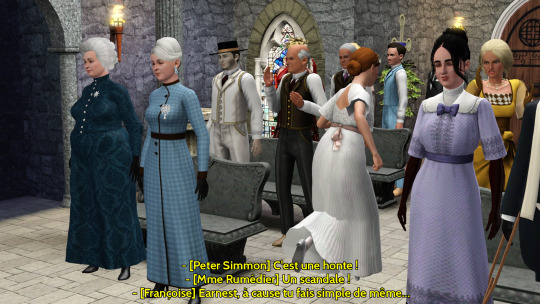


Printemps 1918, Al Simhara, Égypte (13/20)
Pour échapper à la conscription, qui concerne donc un tiers des Canadiens, des milliers d’hommes ont fui dans la nature et sont partis s’installer dans les forêts les plus reculées du pays. Ce maudit niaiseux de Simmon est donc parti sans demander son reste, en catimini le matin de ses noces, s’ermiter dans je ne sais quelle cabane de bûcheron pour échapper à son service militaire, plantant là sa famille et la mienne, ma fille, et ma cérémonie qui avait déjà été réglée ! La nouvelle de la conscription était tombée la veille, et, tous occupés que nous étions aux préparatifs du mariage, nous n’y avions pas pris garde.
[Transcription] Napoléon Bernard : Ah, Mme Rumédier est de retour. Nous allons enfin avoir des explications. Louise Le Bris : Ada, l’as-tu trouvé ? Ada Simmon : Le majordome dit que Mr. Simmon est déjà parti ! Napoléon Bernard : Enfin, vous voyez bien qu’il n’est pas là ! C’est du jamais vu ! Se perdre sur un trajet de cinq cent mètres, le jour de son mariage ? Louise Le Bris : Peut-être que si nous attendons encore un peu… Napoléon Bernard : Il va falloir se faire une raison, Mlle Le Bris… Louise Le Bris : S’il-vous-plaît, Révérend… Napoléon Bernard : Ça fait deux heures que nous attendons, et Mr. Simmon n’est toujours pas là. Il faut annuler le mariage. Peter Simmon : C’est une honte ! Marie Rumédier : Un scandale ! Françoise Simmon : Earnest, à cause tu fais simple de même… Peter Simmon : Ce garçon est déshérité ! Je le raye de mon testament ! Jules Le Bris : Humilier comme ça ma fille… Ça ne peut pas rester impuni ! Adolph Simmon : Ne vous en faites pas, Le Bris, si j’attrape mon fils, je m’en occuperai moi-même.
#ts3#simblr#legacy challenge#history challenge#decades challenge#lebris#lebrisgen3ter#Jules Le Bris#Eugénie Bernard#Louise Le Bris II#Earnest Simmon#Françoise Le Bris#Napoléon Bernard#Adolph Simmon#Peter Simmon#Ada Simmon#Marie Rumédier
8 notes
·
View notes
Text
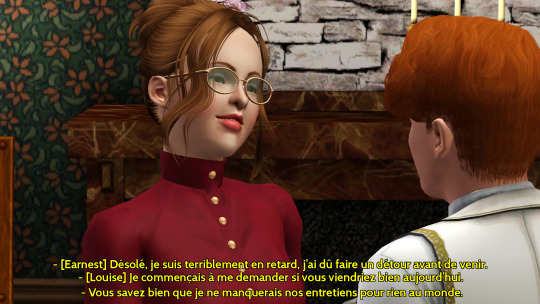
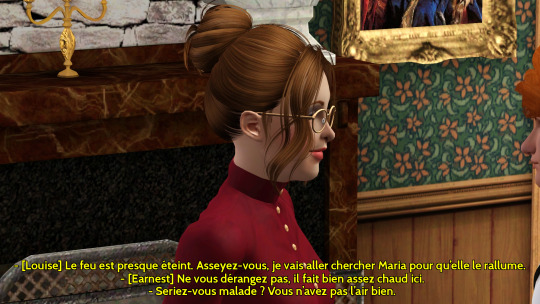
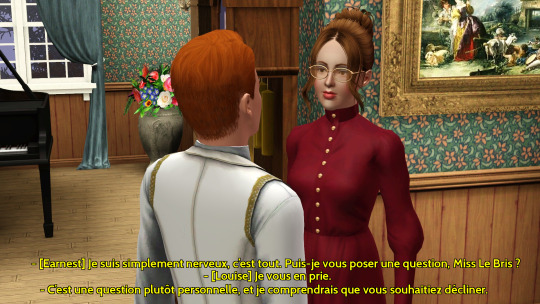
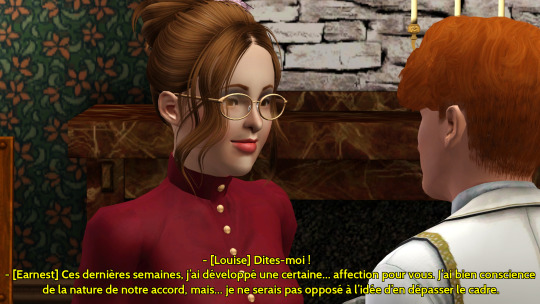
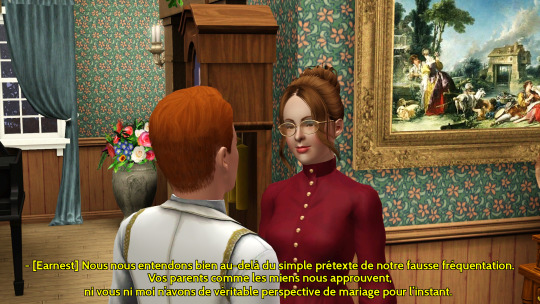
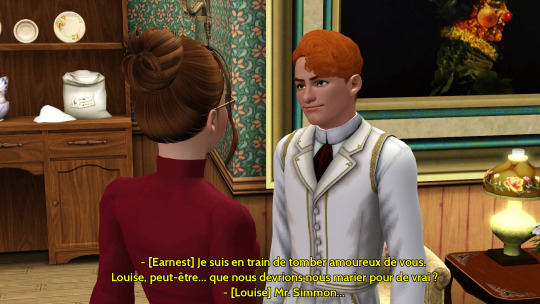
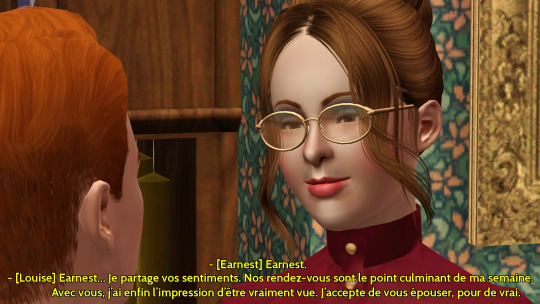

⚠️ CW : Propos misogynes d'un homme blanc de 1918 ⚠️
Printemps 1918, Al Simhara, Égypte (5/20)
À ce propos - et je vous promets qu’il s’agit de la dernière de mes digressions, les femmes blanches nées au Canada de plus de vingt-et-un ans ont désormais le droit de vote aux élections fédérales. Il faut qu’elles soient également propriétaires, ce qui exclue de facto ma fille aînée. Je ne suis pas très familier de la politique française, les femmes ont-elles le droit de vote chez vous, et si oui, quelles en sont les conditions ? Je n’ai pas le sentiment que cette loi ait provoqué beaucoup d'émotion autour de moi. Je dirais que chez les femmes de l’île, les sentiments étaient partag��s. Un tiers était enthousiaste, un tiers y était opposé, un tiers était indifférent. Les hommes y sont, je pense, majoritairement opposés, mais je fais moi-même partie des indifférents - mais je suis indifférent à mon propre vote.
Je lis toutes sortes d’opinions dans le journal à ce sujet. Les partisans disent que de la propriété et de la taxation vient le droit légitime d’être représenté, et puisque les femmes sont propriétaires et taxées en raison de leur propriété, il n’est que naturel qu’elles puissent voter. Les opposants argumentent que le vote est l’expression d’une décision, et que cette décision doit ensuite être imposée et appliquée. Il faut donc être en mesure de pouvoir la défendre si l’opinion majoritaire ne devait pas être entendu, et que donc, en cet état, il n’est pas censé qu’une femme ait le droit de vote car elle se reposerait ensuite sur les hommes de son entourage pour s’assurer que sa décision soit mise en œuvre. Je vois du vrai dans cela également. Cependant cela m’amène à une réflexion. Je n’ai jamais voté de ma vie et je ne compte pas commencer à le faire, mais si je le souhaitais, j’en aurais le droit. Avec ma jambe en moins, je serais cependant bien incapable de reprendre les armes pour défendre la mise en application de mon choix - c’est d’ailleurs parce que l’armée me reconnaît comme incapable de continuer à défendre la nation que j’ai été réformé. Je me demande alors si les opposants argumenteraient qu’il faudrait, à moi aussi, me retirer le droit de vote.
[Transcription] Earnest Simmon : Désolé, je suis terriblement en retard, j’ai dû faire un détour avant de venir. Louise Le Bris : Je commençais à me demander si vous viendriez bien aujourd’hui. Earnest Simmon : Vous savez bien que je ne manquerais nos entretiens pour rien au monde. Louise Le Bris : Le feu est presque éteint. Asseyez-vous, je vais aller chercher Maria pour qu’elle le rallume. Earnest Simmon : Ne vous dérangez pas, il fait bien assez chaud ici. Louise Le Bris : Seriez-vous malade ? Vous n’avez pas l’air bien. Earnest Simmon : Je suis simplement nerveux, c’est tout. Puis-je vous poser une question, Miss Le Bris ? Louise Le Bris : Je vous en prie. Earnest Simmon : C’est une question plutôt personnelle, et je comprendrais que vous souhaitiez décliner. Louise Le Bris : Dites-moi ! Earnest Simmon : Ces dernières semaines, j’ai développé une certaine… affection pour vous. J’ai bien conscience de la nature de notre accord, mais… je ne serais pas opposé à l’idée d’en dépasser le cadre. Earnest Simmon : Nous nous entendons bien au-delà du simple prétexte de notre fausse fréquentation. Vos parents comme les miens nous approuvent, ni vous ni moi n’avons de véritable perspective de mariage pour l’instant. Earnest Simmon : Je suis en train de tomber amoureux de vous. Louise, peut-être… que nous devrions nous marier pour de vrai ? Louise Le Bris : Mr. Simmon… Earnest Simmon : Earnest. Louise Le Bris : Earnest… Je partage vos sentiments. Nos rendez-vous sont le point culminant de ma semaine. Avec vous, j’ai enfin l’impression d’être vraiment vue. J’accepte de vous épouser, pour de vrai.
#ts3#simblr#legacy challenge#history challenge#decades challenge#lebris#lebrisgen3ter#Jules Le Bris#Eugénie Bernard#Louise Le Bris II#Earnest Simmon#Adolph Simmon#Marie-Eugénie Bernard
5 notes
·
View notes